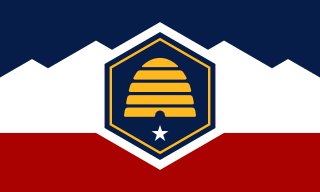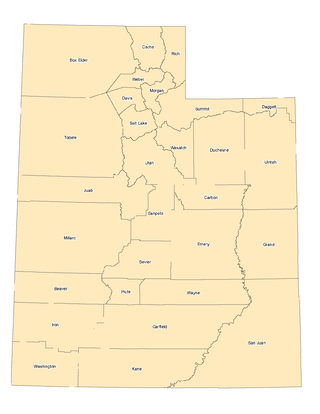
Utah is a landlocked state in the Mountain West subregion of the Western United States. It is bordered to its east by Colorado, to its northeast by Wyoming, to its north by Idaho, to its south by Arizona, and to its west by Nevada. Utah also touches a corner of New Mexico in the southeast. Of the fifty U.S. states, Utah is the 13th-largest by area; with a population over three million, it is the 30th-most-populous and 11th-least-densely populated. Urban development is mostly concentrated in two areas: the Wasatch Front in the north-central part of the state, which is home to roughly two-thirds of the population and includes the capital city, Salt Lake City; and Washington County in the southwest, with more than 180,000 residents. Most of the western half of Utah lies in the Great Basin.

Washington County is a county in the southwestern corner of Utah, United States. As of the 2020 United States Census, the population was 180,279, making it the fifth-most populous county in Utah. Its county seat and largest city is St. George. The county was created in 1852 and organized in 1856. It was named after the first President of the United States, George Washington. A portion of the Paiute Indian Reservation is in western Washington County. Washington County comprises the St. George, UT Metropolitan Statistical Area.

St. George is a city in and the county seat of Washington County, Utah, United States. Located in southwestern Utah on the Arizona border, it is the principal city of the St. George Metropolitan Statistical Area (MSA). The city lies in the northeasternmost part of the Mojave Desert, immediately south of the Pine Valley Mountains, which mark the southern boundary of the Great Basin. St. George lies slightly northwest of the Colorado Plateau, which ends at the Hurricane Fault. The city is 118 miles (190 km) northeast of Las Vegas, Nevada, and 300 miles (480 km) south-southwest of Salt Lake City, Utah, on Interstate 15.

Washington is a city in south central Washington County, Utah, United States and is a part of the St. George Metropolitan Area. The area is also known as Utah's Dixie because the Mormon pioneers who settled the St. George area came to the area to raise cotton, which was milled at the cotton mill in Washington. The population was 27,993 as of 2020. Washington is a fast-growing suburb of St. George, and is the second largest city in Washington County.

U.S. Route 91 or U.S. Highway 91 is a 172.7-mile-long (277.9 km) north–south United States highway running from Brigham City, Utah, to Idaho Falls, Idaho, in the U.S. states of Idaho and Utah. Despite the "1" as the last digit in the number, US 91 is no longer a cross-country artery, as it has mostly been replaced by Interstate 15. The highway currently serves to connect the communities of the Cache Valley to I-15 and beyond. Prior to the mid-1970s, US 91 was an international commerce route from Long Beach, California, to the Canada–US border north of Sweetgrass, Montana. US 91 was routed on the main streets of most of the communities it served, including Las Vegas Boulevard in Las Vegas and State Street in Salt Lake City. From Los Angeles to Salt Lake, the route was built along the corridor of the Arrowhead Trail. A portion of the highway's former route in California is currently State Route 91.

Little Dixie is a historic 13- to 17-county region along the Missouri River in central Missouri, United States. Its early Anglo-American settlers were largely migrants from the hemp and tobacco districts of Virginia, Kentucky, and Tennessee. They brought enslaved African Americans with them or purchased them as workers in the region. Because Southerners settled there first, the pre-Civil War culture of the region was similar to that of the Upper South. The area was also known as Boonslick country.

Utah Tech University (UT), formerly known as Dixie State University (DSU) and similar names, is an open, inclusive, comprehensive, polytechnic 4-year public university in St. George, Utah. The university offers doctoral degrees, master's degrees, bachelor's degrees, associate degrees, and certifications. As of fall 2022, there are 12,556 students enrolled at UT.

KMYU is a television station licensed to St. George, Utah, United States, serving as the MyNetworkTV affiliate for the state of Utah. It is owned by Sinclair Broadcast Group alongside Salt Lake City–based CBS affiliate KUTV and independent station KJZZ-TV. The stations share studios on South Main Street in downtown Salt Lake City, while KMYU's transmitter is located atop Webb Hill, 2+1⁄4 miles (3.6 km) south of downtown St. George. Previously, KMYU-TV maintained separate studios in the J. C. Snow Building on East St. George Boulevard in downtown St. George, while KUTV's facilities only housed KMYU-TV's master control and some internal operations.

Stephen Harold Urquhart is an American politician and religious leader from Utah. A Republican, he was a member of the Utah State Senate, representing the State's 29th Senate district in Washington County from 2009 to 2016, and he served in the Utah House of Representatives from 2001 to 2009.

Grafton is a ghost town, just south of Zion National Park in Washington County, Utah, United States. Said to be the most photographed ghost town in the West, it has been featured as a location in several films, including 1929's In Old Arizona—the first talkie filmed outdoors—and the classic Butch Cassidy and the Sundance Kid. The nearest inhabited town is Rockville, which now includes the Grafton ghost town inside its legal boundaries.
Intermountain St. George Regional Hospital is a 284-bed hospital located on two campuses in St. George, Utah, United States. St. George Regional is the major medical referral center for northwestern Arizona, southeastern Nevada and southern Utah. St. George Regional is fully accredited by the Joint Commission on Accreditation of Healthcare Organizations and is a service of Intermountain Healthcare, a nonprofit health care system serving the Intermountain West. It is also a Level II Trauma Center.

The landlocked U.S. state of Utah is known for its natural diversity and is home to features ranging from arid deserts with sand dunes to thriving pine forests in mountain valleys. It is a rugged and geographically diverse state at the convergence of three distinct geological regions: the Rocky Mountains, the Great Basin, and the Colorado Plateau.

Duncan's Retreat is a ghost town located just off Utah State Route 9 in the eastern part of Washington County, in southwestern Utah, United States. Lying some 3 miles (4.8 km) east of Virgin and just southwest of Zion National Park, Duncan's Retreat was inhabited about 1861–1895.

Dixie, also known as Dixieland or Dixie's Land, is a nickname for all or part of the Southern United States. While there is no official definition of this region, or the extent of the area it covers, most definitions include the U.S. states below the Mason–Dixon line that seceded and comprised the Confederate States of America, almost always including the Deep South. The term became popularized throughout the United States by songs that nostalgically referred to the American South.
Douglas D. Alder was an American historian and academic administrator who was president of Dixie College from 1986 to 1993.
Nellie McArthur Gubler was a genealogist and notable citizen of Santa Clara, Utah.She worked to collect materials related to southern Utah history, which has aided in books written about the location. She was given multiple awards due to her contributions to history and research. She was an active member of the Church of Jesus Christ of Latter-day Saints, where she worked with the Primary children's organization. Gubler also published books on the history of Santa Clara, specifically about the LDS church's history there. In 1929, she married Emil Gubler and had 12 children.

Greater Zion Stadium, originally Hansen Stadium and later Trailblazer Stadium, is a stadium on the campus of Utah Tech University in St. George, Utah. It is primarily used for American football, and is the home field of the Utah Tech Trailblazers football and soccer programs. The stadium holds 10,500 people. In 2002 and 2003, it hosted the Paradise Bowl which was a post season college football all-star game. After the seating expansion in 2017, Greater Zion Stadium became the largest stadium in the southern portion of Utah.
Mary Lou Romney, born Mary Louisa Stone, was an American Painter who resided in Utah. Romney studied art at the University of Utah where she earned a BFA and then completed a Post Graduate Education Certification program. She continued her education at Utah State University where she earned an MFA with a minor in Education. She was a nationally recognized painter and illustrator. She taught briefly at Utah State University, then spent many years teaching at the University of Utah, and was involved in local and regional art organizations, exhibits, and contests.
















